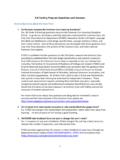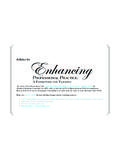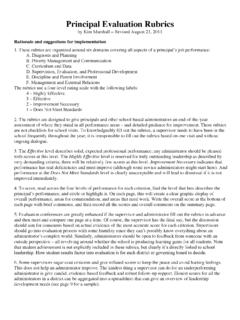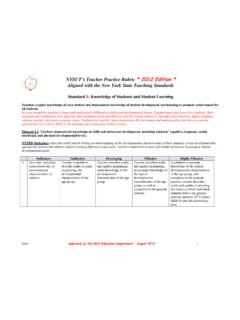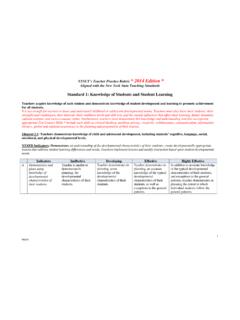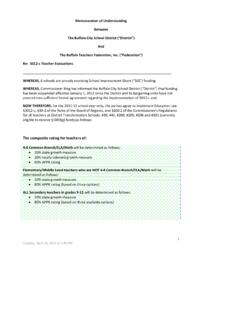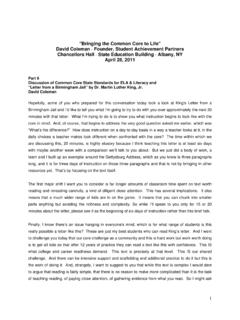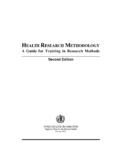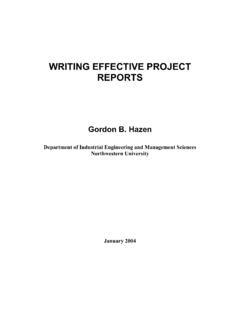Transcription of Appendix B: Teacher Self-Assessment Guide
1 Appendix B: Teacher Self-Assessment Guide The Thoughtful Classroom Teacher effectiveness Framework Teacher Self-Assessment Guide Organization, Rules, Preparing Students Positive Relationships and Procedures for New Learning How do you organize your How do you establish your How do you build deep and classroom to enhance learning and purpose, activate students' meaningful relationships with your establish rules and procedures prior knowledge, and prepare students and among students? that clarify expectations? them for learning? Deepening Learning Presenting New Learning Helping Students Reflect on and Celebrate Learning How do you help students How do you present new How do you help students look solidify their understanding information and provide back on their learning and refine and practice new skills?
2 Opportunities for students to their learning process? actively engage with content? A Culture of Thinking Applying Learning Engagement and Enjoyment and Learning How do you develop a classroom How do students demonstrate How do you motivate students culture that promotes serious their learning and what kinds of to do their best work and inspire learning and sophisticated evidence do you collect to assess the love of learning? forms of thinking? their progress? NEW YORK STATE. 2011 Silver Strong & Associates | PROPRIETARY: No part of this work may be reproduced or transmitted in any form or by any means without permission from Silver Strong & Associates.
3 The Thoughtful Classroom Teacher effectiveness Framework TABLE OF CONTENTS FOR Teacher Self-Assessment Guide . Overview & Where This Model Comes From 1. This section provides teachers with an overview of how The Thoughtful Classroom Teacher effectiveness Framework is organized and its foundation in current research. Self-Assessment and Reflection Forms 3. Teachers use these forms one for each dimension to self-assess their effectiveness for various indicators on a 1-4 rating scale. After self-assessing their effectiveness using these indicators, teachers will have an opportunity to reflect on their practice, collect evidence, and generate ideas to improve their planning and implementation.
4 1. Organization, Rules, and Procedures 3. 2. Positive Relationships 6. 3. Engagement and Enjoyment 9. 4. A Culture of Thinking and Learning 12. 5. Preparing Students for New Learning 15. 6. Presenting New Learning 18. 7. Deepening Learning 21. 8. Applying Learning 24. 9. Helping Students Reflect on and Celebrate Learning 27. 10. Professional Practice 30. References 31. TCTEF| Teacher Self-Assessment Guide | PROPRIETARY. The Thoughtful Classroom Teacher effectiveness Framework OVERVIEW & WHERE THIS MODEL COMES FROM. Overview This framework provides teachers and administrators with a comprehensive system for assessing, discussing, and refining classroom practice.
5 It synthesizes the insights from a wide body of research on instructional design and Teacher - effectiveness models. It is ideal for use as a Self-Assessment tool by teachers and as a supervision/observation tool by administrators. The ultimate goal of this framework is to create a common language for talking about what constitutes high-quality teaching and how classroom practice can be improved. This framework allows for assessment according to nine dimensions of teaching and outlines a set of specific and observable teaching behaviors within each dimension. Each behavior can be assessed quantitatively using the rating scale that precedes each series of questions.
6 In addition, this framework provides room for comments and notes within each dimension, allowing for deeper and more nuanced assessments. Where This Model Comes From This model is made up of two components: I. Instructional Design and Delivery II. Cornerstones of Effective Teaching Component One: Instructional Design and Delivery At the heart of this framework is a knowledge construction model synthesizing the best research on instructional design, including Madeline Hunter's classic Elements of Lesson Design (1984). Grant Wiggins and Jay McTighe's Understanding by Design (2005). Robert Marzano's The Art and Science of Teaching (2007).
7 A wide body of research into how schools can prepare students for 21st-century careers, global citizenship, and the demands of the knowledge-based economy. Preparing Students for New Learning (Knowledge Anticipation). Deepening Learning Presenting Helping Students Reflect (Practicing and Processing New Learning on and Celebrate Learning New Knowledge) (Knowledge Acquisition) (Reflecting on New Knowledge). Applying Learning (Knowledge Application). THE THOUGHTFUL CLASSROOM Teacher effectiveness FRAMEWORK | 2011 Silver Strong & Associates | 1. PROPRIETARY: No part of this work may be reproduced or transmitted in any form or by any means without permission from Silver Strong & Associates.
8 TCTEF| Teacher Self-Assessment Guide | PROPRIETARY. Component Two: The Four Cornerstones of Effective Teaching Around the framework are four foundational elements that support teaching and learning, adapted from the pre-eminent Teacher - effectiveness models, including Charlotte Danielson's Enhancing Professional Practice (2007). Robert Marzano's The Art and Science of Teaching (2007). Robert Marzano, Tony Frontier, and David Livingston's Effective Supervision: Supporting the Art and Science of Teaching (2011). Jon Saphier, Mary Ann Haley-Speca, and Robert Gower's The Skillful Teacher (2008). Pamela Tucker and James Stronge's Linking Teacher Evaluation and Student Learning (2005).
9 Organization, Rules, and Positive Relationships Procedures A Culture of Thinking Engagement and and Learning Enjoyment Components One and Two Combine to Create a Complete Framework with Nine Dimensions Preparing Students Organization, Rules, and for New Learning Positive Relationships Procedures (Knowledge Anticipation). Deepening Learning Presenting Helping Students Reflect (Practicing and Processing New Learning on and Celebrate Learning New Knowledge) (Knowledge Acquisition) (Reflecting on New Knowledge). Applying Learning A Culture of Thinking (Knowledge Application) Engagement and and Learning Enjoyment Looking Beyond the Classroom In addition to the nine dimensions presented above, this framework also includes a tenth dimension for assessment.
10 This tenth dimension addresses the important non-instructional responsibilities of teachers, including their commitment to ongoing learning, leadership, and the school community. THE THOUGHTFUL CLASSROOM Teacher effectiveness FRAMEWORK | 2011 Silver Strong & Associates | 2. PROPRIETARY: No part of this work may be reproduced or transmitted in any form or by any means without permission from Silver Strong & Associates. TCTEF| Teacher Self-Assessment Guide | PROPRIETARY. Cornerstone DIMENSION ONE: ORGANIZATION, RULES, AND PROCEDURES. Overview Our first cornerstone of effective teaching has to do with the rules, procedures, classroom policies, and organizational decisions that underlie effective classroom management.
